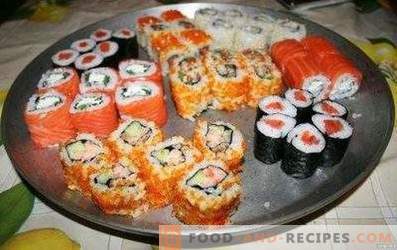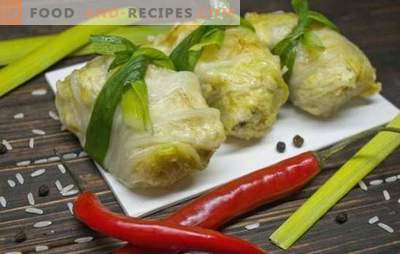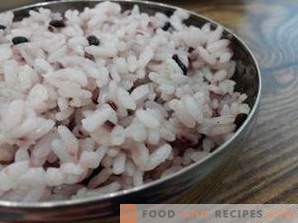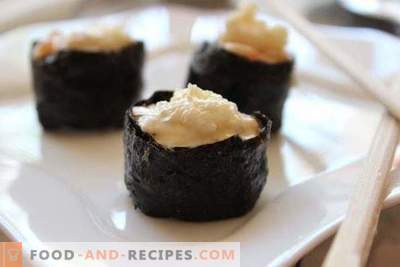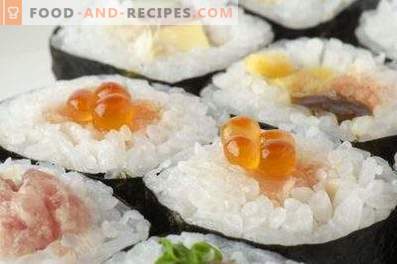
There are a lot of fans of Japanese cuisine in our country. They are seduced by the balance of the Asian diet and the unique taste of local dishes. Among the most popular Japanese dishes among our compatriots are rolls. Specialized cafes and restaurants offer them in an assortment, but at high prices. Meals, sold at an affordable price in some supermarkets, do not always meet the expectations of customers. If you want to eat Japanese dishes often, but the family budget is not enough to regularly visit Japanese restaurants, the only solution is to learn how to make rolls at home. In most supermarkets you can buy a full range of products that are required for the preparation of such dishes. From the kitchen utensils, you will need only a knife and a bamboo mat, the acquisition of which also will not ruin you.
Cooking Features
Cooking rolls is a kind of art, this process requires a certain culinary skill. However, this does not mean that only a select few can engage in the manufacture of these small rolls of rice and filled seaweed. Any housewife can master this science, you just need to know the technology of making rolls and practice a little.
- Choosing rice is important. If you buy long grain rice, even Japanese will not be able to make rolls of it. For the preparation of rolls, special rice is required, sticky enough to hold the shape, but not sticky during cooking. If you do not have the opportunity to buy special rice for sushi, take the usual round grain rice grown in the Krasnodar region.
- Boil rice for sushi and rolls also need to be correct. Initially, it is poured with water and crumpled with his hands to separate the garbage. Then the water is drained and the procedure is repeated several times until the water remains completely clean. Then rice is poured with water, and water is required to take about one and a half times more rice. On medium heat, water with rice is brought to a boil and boil for 5 minutes. Then the intensity of the flame is reduced, continue to cook the rice over low heat for another 10 minutes. After being removed from the heat and left to reach under the lid for 15 minutes. Separately, they prepare a mixture of sugar, salt and rice vinegar, which can be replaced with apple vinegar, even though it will have a little effect on the taste of the finished dish. To sugar and salt dissolve faster, vinegar can be slightly heated. Cooked sauce poured into rice on a wooden spatula, while stirring it with this device. Before this manipulation of rice is recommended to lay out in a flat bowl. When stirring, the spatula is kept almost horizontal.
- The most difficult in the process of making rolls is the formation of rolls. This will require a bamboo mat and nori - pressed algae. Nori on sale are found in the form of thin strips resembling ribbons, or in the form of sheets. The first option is convenient for sushi, for rolls they take nori in the form of sheets. Nori is placed on the mat, retreating 1, 5-2 cm from the edge, covered with rice so that the top remains a free strip of nori 1 cm wide, and from the bottom the rice slightly protrudes beyond the edges of the algae sheet. Put the stuffing on the rice, placing it closer to the bottom edge. Using a bamboo mat, lift the end of the structure, rolling it into a roll, lightly press or roll. The free edge of the algae moistened with water and complete the formation of the roll.
- Algae are placed so that the rough side of the sheet is on top.
- To prevent the rice from sticking to the hands, they are moistened in water acidified with vinegar.
- The width of the rice layer should be 5-7 mm.
- The mat is recommended to be covered with cling film before use. Then rice and algae will not pester her. In terms of sanitation, this is also a reasonable solution.
- If you want to make rolls, in which rice serves as the outer layer, before laying out the filling, turn the structure of rice and nori, smear it with sauce. The top rice layer of such rolls is decorated with slices of salmon, flying fish roe or sesame seeds.
- Cut the cooked rolls, starting from the middle. Then halves divide a sharp knife into 3-4 parts.
- To keep the knife from sticking to rice, it is moistened with vinegar.
- The Japanese are conservative, honor traditions and perform rituals exactly. However, this conservatism does not apply to rolls fillings. In this matter, the cook has the freedom to choose. Most often, rolls are stuffed with fish and seafood, fresh vegetables, but they are made with meat, chicken, and fruit.
- Rolls are served most often with soy sauce and ginger. High-quality soy sauce is made by fermentation, does not contain preservatives and artificial colors, is sold in bottles of glass. Ginger serves to prepare taste buds for the evaluation of the organoleptic qualities of a new roll. If all products are the same, they can be ginger and not to have a snack.
- Often rolls complement wasabi. Buy this sauce is better in powder. To get the sauce, it is enough to dissolve it with water, and such a product will cost less than in the form of ready-to-eat pasta.
Traditionally, rolls are eaten with special chopsticks. Not all Europeans own them well enough. If you do not have these skills, it’s wiser to ask for a fork. Even Asians themselves sometimes eat rolls with European appliances, and Japanese etiquette allows men to take rice rolls even with their hands.
A simple recipe for salmon rolls (“Syake Maki”)
Composition:
- rice cereal - 80 g;
- water - 150 ml;
- salt - a large shchipot;
- rice or apple vinegar (6 percent) - 20 ml;
- sugar - 5 g;
- nori - 3 leaves;
- salted salmon (fillet) - 150 g;
- wasabi to taste.
Method of preparation:
- Rinse the rice to clear water, cover with clean water, and boil it within 15 minutes after boiling. Remove from heat, cover with lid, wait 15 minutes.
- Add salt and sugar to vinegar. Heat it up slightly. Stir to dissolve sugar and salt.
- Put the rice in a wide bowl. While pouring vinegar into it in a thin stream, stir it.
- Cut the salmon fillet into thin strips.
- Bamboo mat wrap with cling film.
- Cut the leaves of nori in half.
- Put half of the nori sheet on the mat, backing off from the edge of one and a half centimeters.
- Divide the rice into 6 parts, put one part on the algae, smooth and compact with your hands. Hands soak in water, acidified with vinegar, so that the rice does not stick to them. Do not forget to leave the top layer of nori free from rice, and make the bottom layer of rice a little wider, protruding beyond the edge of the algae.
- Apply a thin strip of wasabi, as if charting the line on which the filling should be.
- Place the salmon along this line.
- Form a roll with the help of a mat, fasten its edges.
- Cut the roll into 6 pieces.
- In the same way, prepare the rolls from the remaining ingredients.
As a result, you get 6 servings of rolls of 6 pieces each. Rolls for this recipe are small, so portions can be increased.
Rolls “Philadelphia”
Composition:
- ready rice for rolls or sushi - 0, 3 kg;
- salted red fish - 0, 25 kg;
- cream cheese - 100 g;
- fresh cucumber - 150 g;
- avocados - 0, 2 kg.
Method of preparation:
- Cut the nori sheets into 2 pieces.
- Cut the fish into thin plates.
- Cut the avocado by removing the bone. Clean up. Cut into strips, long but not too thin.
- Wash, dry the cucumber. Slice it just like avocados.
- On a bamboo mat wrapped with cling film, lay a half of a sheet of nori with the smooth side down.
- On the nori lay out a portion of the rice, leaving a free section of the algae on the bottom, and above with rice layer over the edges.
- Seal the rice with your hands.
- Place the salmon plates on top.
- Invert the structure so that the algae are on top.
- Lubricate the nori with cream cheese by drawing a strip.
- Spread slices of cucumber and avocado.
- With the help of the mat, roll everything into a roll.
- Cut the roll into 6 small rolls.
“Philadelphia” rolls are among the most popular types of these products. Their unique gentle and harmonious taste will not leave indifferent any connoisseur of Japanese cuisine.
California Rolls
Composition:
- prepared rice (cooked for rolls) - 0, 3 kg;
- nori - 3-4 leaves;
- flying fish roe - 100 g;
- avocados - 0, 3 kg;
- crab sticks - 100 g.
Method of preparation:
- Cut the crab sticks into several pieces lengthwise.
- Avocados, peeling and sparing from the stone, cut into long strips.
- Cut the leaves of nori into 2 halves.
- Place the nori on a bamboo mat covered with cling film.
- Cover it with rice, leaving a free stretch of nori at the bottom, going above the edge of the algae with a rice layer.
- Tamper, brush with flying fish roe. This product is expensive and difficult to access. If you did not manage to get it, do not worry. Flying fish caviar can be replaced with carp caviar, which has a similar color. Her taste is different, but the rolls with her also turn out delicious.
- Turn the base of the future roll up with a sheet of nori.
- Spread surimi and avocado, roll the billet into a roll, helping yourself with the mat.
- Cut into 6 pieces.
These rolls successfully compete with “Philadelphia” rolls, becoming one of the most favorite dishes of Japanese cuisine by our compatriots.
Baked rolls with shrimp and salmon
Composition:
- rice for rolls (ready) - 0, 2 kg;
- Nori - 3 pcs .;
- shrimp cooked frozen peeled - 100 g;
- salmon fillet - 100 g;
- spicy sauce - 30 ml.
Method of preparation:
- Prepare rice by mixing it with vinegar, salt and sugar.
- Cut the nori into halves.
- Cut the salmon fillet into thin, long pieces.
- Throw the shrimp in boiling water, after 5 minutes remove them with a slotted spoon, cool.
- Bamboo mat (makitu) cover with cling film.
- Put the half of nori on the makita.
- Place the sixth portion of cooked rice tightly. The upper edge of the nori remains free, the rice stands for the lower edge.
- Place the pieces of salmon and shrimp in the center.
- Raising the edge of the rice and the nori with a mat, form a roll. Crimp it through the mat so that it holds its shape better.
- Dampen the edge of the nori with water, ensure it is snug against the rice.
- Cut the roll into 6 pieces, starting to cut from the center.
- Place the rolls in a baking dish with the flat side up.
- Cover with sauce.
- Place the form in an oven preheated to 180 degrees, bake for 15 minutes.
Rolls for this recipe are satisfying. They are often preferred by people who love hot snacks.
Sweet Rolls
Composition:
- rice (groats) - 0, 2 kg;
- cream - 0, 25 l;
- milk - 150 ml;
- Kiwi - 100 g;
- peach - 150 g;
- sugar - 60 g;
- vanillin - 1 g;
- cream cheese - 150 g;
- coconut chips - how much will leave.
Method of preparation:
- Wash fruit. Peel the Kiwi. Remove the bone from the peach.
- Cut the fruit into strips.
- Rice rinse well.
- Mix milk with cream, vanilla and sugar, add 100 g of coconut chips.
- Heat the mixture, add rice to it. Cook it over low heat for half an hour. If liquid remains in the pan by this time, drain it.
- Rice with a layer of 5-7 mm lay on a bamboo mat covered with cling film. Flatten it and tamp it.
- Grease with cream cheese, lay out the fruit filling.
- Roll the rice into a roll using the rug.
- Dip it in coconut flakes.
- Store the roll for an hour in the fridge.
Before serving, the roll is cut into 6 pieces. The result is sweet rolls with fruit filling and coconut aroma, they are nourishing, but they are pleasant as an exquisite dessert. This treat will surely enjoy the children.
Rolls - a traditional dish of Japanese cuisine, extremely popular in our country. You can cook them at home. Not all of them get beautiful the first time, but gradually they succeed better and better.



